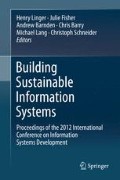Abstract
The increased adoption of IT by all organizations has led to more complex IT infrastructures, enforcing the need for guidelines that will allow the alignment and management between an organization’s architectures. To answer this need, different frameworks in the IT Governance area have been proposed, namely the widely adopted IT Service Management framework (ITIL) as well as different frameworks following Enterprise Architecture principles. In a time when rationalization is necessary and convergence and aggregation are motto, maintaining these two approaches, which may in fact overlap in some points, is an inefficient waste of resources. In literature review and framework research, we noticed few scientific references regarding integration, which increases the theme’s relevance. Considering that both these domains are complementary, this paper pro-poses the integration between ITIL and Enterprise Architecture principles, with Services as the integration key point.
Access this chapter
Tax calculation will be finalised at checkout
Purchases are for personal use only
References
Spewak S, Hill S (eds) (1992) Enterprise architecture planning: developing a blueprint for data, applications and technology. Wiley-QED, New York
Zachman J (1987) A framework for information systems architecture. IBM Syst J 26:276–292
Gama N, Silva R, Mira da Silva M (2011) Using people-CMM for diminishing resistance to ITIL. Int J Human Capital Information Technol Prof (IJHCITP) 2:29–43
Brenner M (2006) Classifying ITIL processes; a taxonomy under tool support aspects. Business-driven IT management, Vancouver, Canada, pp 19–28
Gama N, Mira da Silva M, Francisco RA (2011) A conceptual framework for structuring an IT organisation. 16th Annual conference of the UKAIS, Oxford, England
Hochstein A, Zarnekow R, Brenner W (2005) ITIL as common practice reference model for IT service management: formal assessment and implications for practice. International conference EEE. IEEE Computer Society, pp 704–710
Correia A, Abreu FB e (2009) Integrating IT service management within the enterprise architecture. 4th International conference on software engineering advances (ICSEA), Porto, Portugal, pp 553–558
Johnson MW, Hately A, Miller BA, Orr R (2007) Evolving standards for IT service management. IBM Syst J 46:583–597
Sharifi M, Ayat M, Rahman AA, Sahibudin S (2008) Lessons learned in ITIL implementation failure. International symposium on information technology (ITSim 2008), vol. 2, Kuala Lumpur, Malaysia, pp 1–4
Braun C, Winter R (2007) Integration of IT service management into enterprise architecture. In: ACM (ed) ACM symposium on applied computing, New York, pp 1215–1219
Nabiollahi A, Alias RA, Sahibuddin S (2010) A service based framework for integration of ITIL V3 and enterprise architecture. 2010 International symposium in information technology (ITSim), vol. 1, Kuala Lumpur, pp 1–5
Thorn S (2007) TOGAF and ITIL. In: The Open Group (ed), vol. Catalog number W071, San Francisco, CA, p 26
Hevner AR, March ST, Park J, Ram S (2004) Design science in information systems research. MIS Quarterly 28:75–105
Oates BJ (2006) Researching information systems and computing. Sage, Beverly Hills, CA
March ST, Smith GF (1995) Design and natural science research on information technology. Decis Support Syst 15:251–266
Peffers K, Tuunanen T, Rothenberger M, Chatterjee S (2007) A design science research methodology for information systems research. J Manage Inform Syst(24)
The Open Group (2011) The Open Group architecture framework (TOGAF). Version 9, http://www.opengroup.org/togaf/
Lankhorst M (2009) Enterprise architecture at work. Springer, New York
Ross JW, Weill P, Robertson DC (eds) (2006) Enterprise architecture as strategy: creating a foundation for business execution. Harvard Business School Press, Boston, MA
Schekkerman J (2006) The economic benefits of enterprise architecture: how to quantify and manage the economic value of enterprise architecture. Trafford, Victoria, BC
Winter R, Fischer R (2007) Essential layers, artifacts, and dependencies of enterprise architecture. J Enterprise Architecture 3:7–18
Pereira C, Sousa P (2004) A method to define an enterprise architecture using the Zachman framework. In: ACM (ed) The 19th annual ACM symposium on applied computing (SAC'04), Nicosia, Cyprus, pp 1366–1371
Schekkerman J (ed) (2004) How to survive in the jungle of enterprise architecture frameworks. Trafford, Victoria, BC
Taylor S, Lloyd V, Rudd C (eds) (2007) ITIL: service design. TSO, Norwich
Wout JVW, Waage M, Hartman H, Stahlecker M, Hofman A (2010) The integrated architecture framework explained: why, what, how. Springer, New York
Tsai W-T, Chen Y, Fan C (2006) PESOI: process embedded service-oriented architecture. J Software 17:1470–1484
Chen H (2008) Towards service engineering: service orientation and business-IT alignment. 41st Hawaii international conference on system sciences, IEEE Computer Society, Waikoloa, HI p 114
Alwadain A, Korthaus A, Fielt E, Rosemann M (2010) Integrating SOA into an enterprise architecture: a comparative analysis of alternative approaches. 5th IFIP CONFENIS, Natal, Brazil, pp 1–15
Haki MK, Forte MW (2010) service-oriented business-IT alignment: a SOA governance model. AISS Adv Inform Sci Service Sci 2:51–60
Noran O, Bernus P (2008) Service oriented architecture vs. enterprise architecture: competition or synergy? Lect Notes Comput Sc 5333:304–312
Alwadain A Erwin F, Korthaus A, Rosemann M (2011) Where do we find services in enterprise architectures? A comparative approach. ACIS, Sydney, Australia
Shanks G, Tansley E, Weber R (2003) Using ontology to validate conceptual models. Commun ACM 46:85–89
Novak JD, Cañas AJ (2008) The theory underlying concept maps and how to construct and use them. Technical Report, Florida Institute for Human and Machine Cognition (IHMC)
Mintzes JJ, Wandersee JH, Novak JD (2000) Assessing science understanding: a human constructivist view. Elsevier Academic Press, San Diego, CA
Kieninger A, Baltadzhiev D, Schmitz B, Satzger G (2011) Towards service level engineering for IT services: defining IT services from a line of business perspective. Annual SRII global conference (SRII), 2011, San Jose, CA, pp 759–766
Author information
Authors and Affiliations
Corresponding author
Editor information
Editors and Affiliations
Rights and permissions
Copyright information
© 2013 Springer Science+Business Media, LLC
About this paper
Cite this paper
Gama, N., Sousa, P., da Silva, M.M. (2013). Integrating Enterprise Architecture and IT Service Management. In: Linger, H., Fisher, J., Barnden, A., Barry, C., Lang, M., Schneider, C. (eds) Building Sustainable Information Systems. Springer, Boston, MA. https://doi.org/10.1007/978-1-4614-7540-8_12
Download citation
DOI: https://doi.org/10.1007/978-1-4614-7540-8_12
Published:
Publisher Name: Springer, Boston, MA
Print ISBN: 978-1-4614-7539-2
Online ISBN: 978-1-4614-7540-8
eBook Packages: Computer ScienceComputer Science (R0)

